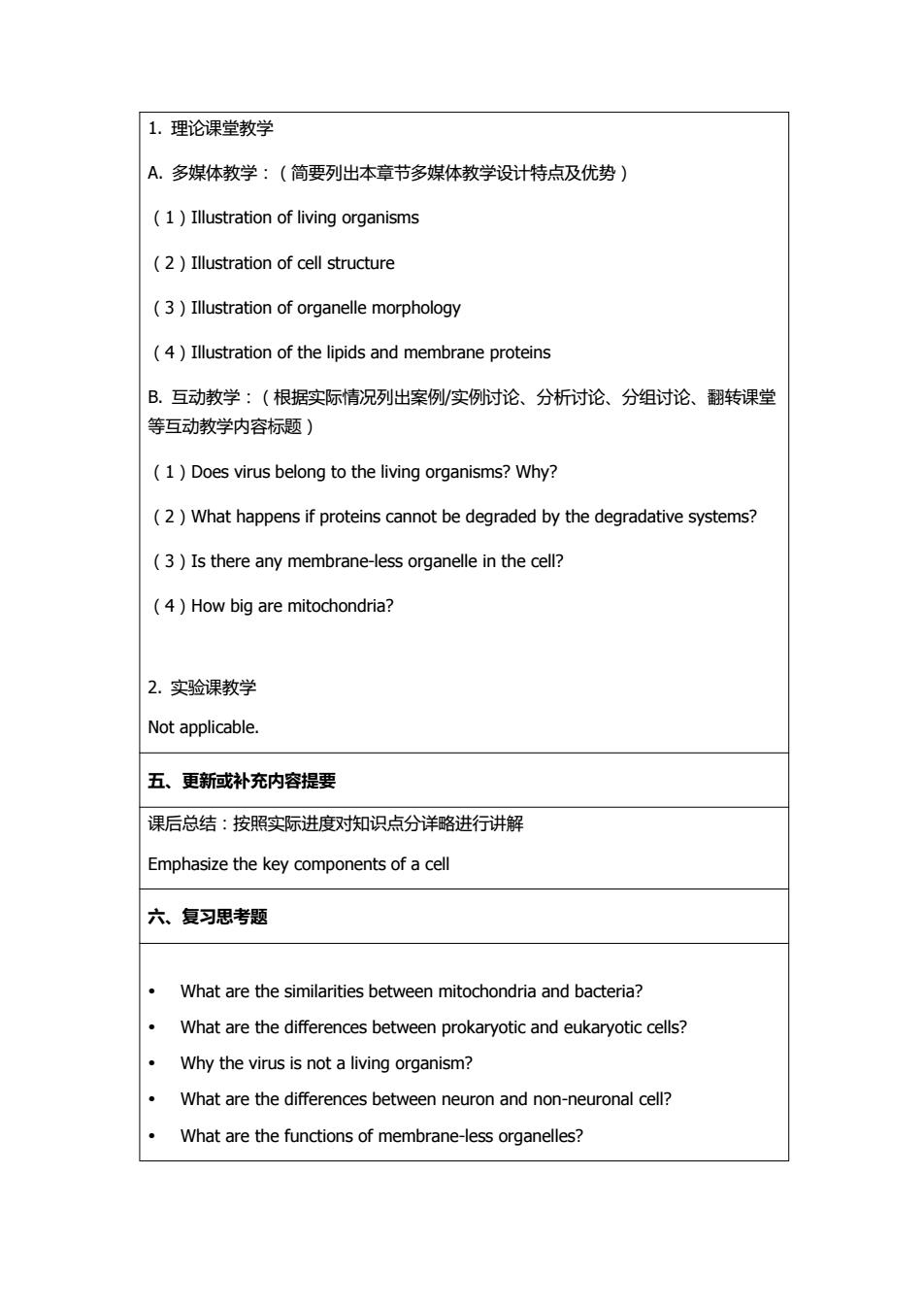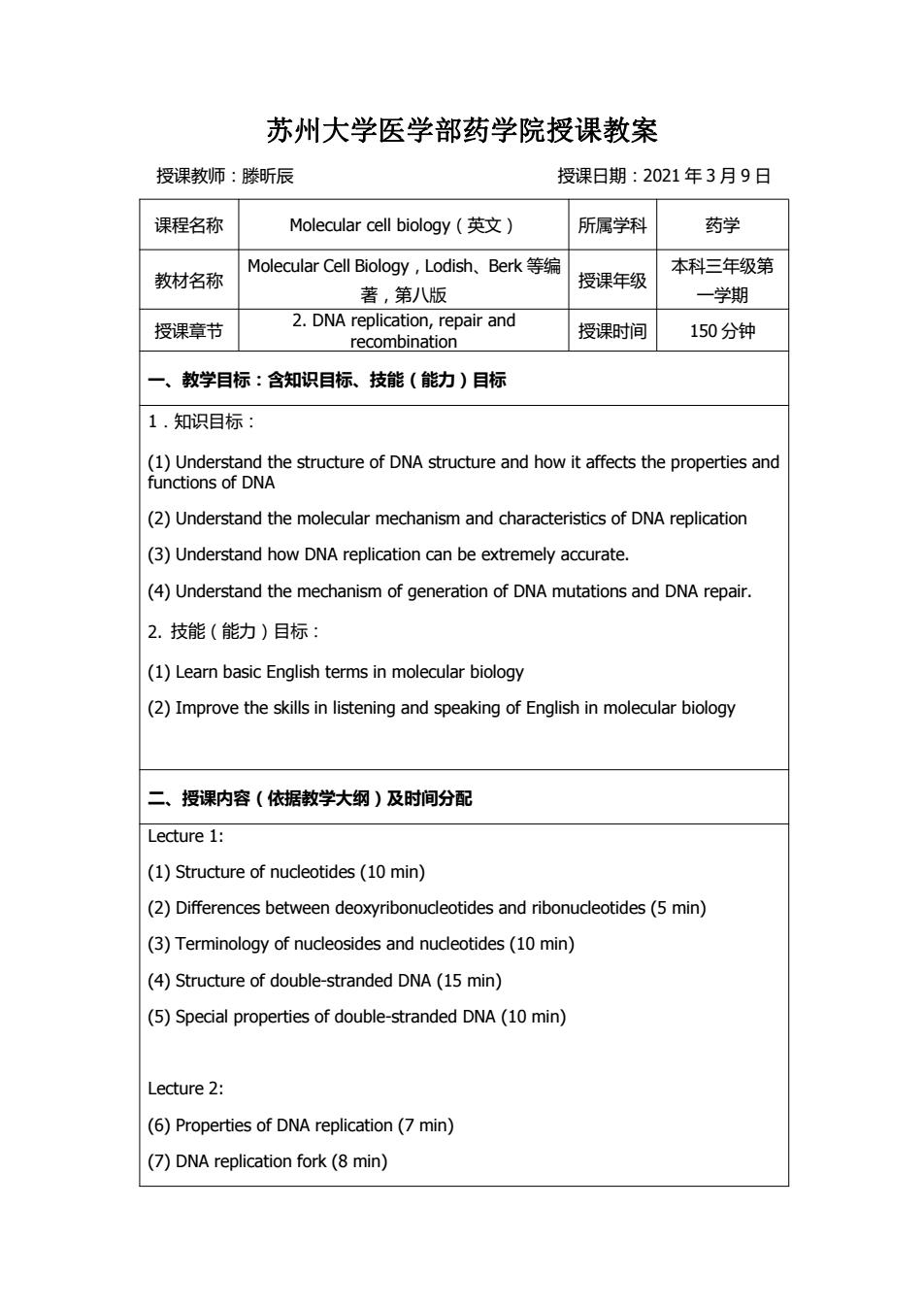
苏州大学医学部药学院授课教案 授课教师:应征 授课日期:2021年3月2日 课程名称 Molecular cell biology(英文) 所属学科 药学 Molecular Cell Biology,Lodish、Berk等编 本科三年级第 教材名称 授课年级 著,第八版 一学期 授课章节 1.Cell structure and function 授课时间 150分钟 一、教学目标:含知识目标、技能(能力)目标 1.知识目标: (1)Understand the basic concept of molecular cell biology. (2)Understand the relationship cell biology and molecular biology. (3)Understand the morphology of intracellular organelles. (4)Understand the basic functions of intracellular organelles. 2.技能(能力)目标: (1)Learn basic English terms in cell biology (2)Improve the skills in listening and speaking of English in cell biology 二、授课内容(依据教学大纲)及时间分配 Lecture 1: (1)Brief review of the living organisms(10 min) (2)the common ancestral cell for all living organisms(5 min) (3)The size of virus,prokaryotic and eukaryotic cells(5 min) (4)The general location and forms of the genome in cells and viruses(15 min) (5)The differences between virus,prokaryotic and eukaryotic cells(15 min) Lecture 2: (6)A virus is not a living organism (10 min) (7)A virus is a microscopic particle that can infect the cells(10 min) (8)The structure of naked virus and enveloped virus(15 min)
苏州大学医学部药学院授课教案 授课教师:应征 授课日期:2021 年 3 月 2 日 课程名称 Molecular cell biology(英文) 所属学科 药学 教材名称 Molecular Cell Biology,Lodish、Berk 等编 著,第八版 授课年级 本科三年级第 一学期 授课章节 1. Cell structure and function 授课时间 150 分钟 一、教学目标:含知识目标、技能(能力)目标 1.知识目标: (1) Understand the basic concept of molecular cell biology. (2) Understand the relationship cell biology and molecular biology. (3) Understand the morphology of intracellular organelles. (4) Understand the basic functions of intracellular organelles. 2. 技能(能力)目标: (1) Learn basic English terms in cell biology (2) Improve the skills in listening and speaking of English in cell biology 二、授课内容(依据教学大纲)及时间分配 Lecture 1: (1) Brief review of the living organisms (10 min) (2) the common ancestral cell for all living organisms (5 min) (3) The size of virus, prokaryotic and eukaryotic cells (5 min) (4) The general location and forms of the genome in cells and viruses (15 min) (5) The differences between virus, prokaryotic and eukaryotic cells (15 min) Lecture 2: (6) A virus is not a living organism (10 min) (7) A virus is a microscopic particle that can infect the cells (10 min) (8) The structure of naked virus and enveloped virus (15 min)

(9)The origin of the virus:3 major hypothesis(15 min) Lecture 3: (10)The size of mitochondrion,ER,endosome,lysosome and proteasome in cells(10 min) (11)Membrane contacts in cells:function and dynamics(15 min) (12)Membrane-less organelles and phase separation in cells(10 min) (13)The structure and function of non-neuronal and neuronal cells(15 min) 三、教学重点与难点 1.教学重点 (1)Organisms and virus (2)Prokaryotic and eukaryotic cells (3)The function and localization of various intracellular compartments 2.教学难点 (1)Membrane contact sites between different organelles (2)The similarity and difference between non-dividing and dividing cells 四、教学方法选择
(9) The origin of the virus: 3 major hypothesis (15 min) Lecture 3: (10) The size of mitochondrion, ER, endosome, lysosome and proteasome in cells (10 min) (11) Membrane contacts in cells: function and dynamics (15 min) (12) Membrane-less organelles and phase separation in cells (10 min) (13) The structure and function of non-neuronal and neuronal cells (15 min) 三、教学重点与难点 1.教学重点 (1) Organisms and virus (2) Prokaryotic and eukaryotic cells (3) The function and localization of various intracellular compartments 2. 教学难点 (1) Membrane contact sites between different organelles (2) The similarity and difference between non-dividing and dividing cells 四、教学方法选择

1.理论课堂教学 A.多媒体教学:(简要列出本章节多媒体教学设计特点及优势) (1)Illustration of living organisms (2)Illustration of cell structure (3 )Illustration of organelle morphology (4)Illustration of the lipids and membrane proteins B.互动教学:(根据实际情况列出案例/实例讨论、分析讨论、分组讨论、翻转课堂 等互动教学内容标题) (1 Does virus belong to the living organisms?Why? (2)What happens if proteins cannot be degraded by the degradative systems? (3)Is there any membrane-less organelle in the cell? (4)How big are mitochondria? 2.实验课教学 Not applicable. 五、更新或补充内容提要 课后总结:按照实际进度对知识点分详略进行讲解 Emphasize the key components of a cell 六、复习思考题 What are the similarities between mitochondria and bacteria? What are the differences between prokaryotic and eukaryotic cells? Why the virus is not a living organism? What are the differences between neuron and non-neuronal cell? What are the functions of membrane-less organelles?
1. 理论课堂教学 A. 多媒体教学:(简要列出本章节多媒体教学设计特点及优势) (1)Illustration of living organisms (2)Illustration of cell structure (3)Illustration of organelle morphology (4)Illustration of the lipids and membrane proteins B. 互动教学:(根据实际情况列出案例/实例讨论、分析讨论、分组讨论、翻转课堂 等互动教学内容标题) (1)Does virus belong to the living organisms? Why? (2)What happens if proteins cannot be degraded by the degradative systems? (3)Is there any membrane-less organelle in the cell? (4)How big are mitochondria? 2. 实验课教学 Not applicable. 五、更新或补充内容提要 课后总结:按照实际进度对知识点分详略进行讲解 Emphasize the key components of a cell 六、复习思考题 What are the similarities between mitochondria and bacteria? What are the differences between prokaryotic and eukaryotic cells? Why the virus is not a living organism? What are the differences between neuron and non-neuronal cell? What are the functions of membrane-less organelles?

七、学习资源、课外自主学习参考 (可以列出供学生进一步学习、拓展本章节内容的网站、著作、期刊的名称及内容等) Molecular Biology of the Cell,Alberts等编著,第六版,2014年出版,Garland Science Molecular Biology::Principles and Practice,.Michael Cox等编著,第二版,20l5 年出版,W.H.Freeman and Company Molecular Biology,,Robert Weaver,第五版,2012年出版,McGraw-Hil
七、学习资源、课外自主学习参考 (可以列出供学生进一步学习、拓展本章节内容的网站、著作、期刊的名称及内容等) Molecular Biology of the Cell,Alberts 等编著,第六版,2014 年出版,Garland Science Molecular Biology: Principles and Practice, Michael Cox 等编著, 第二版,2015 年出版,W. H. Freeman and Company Molecular Biology, Robert Weaver, 第五版,2012 年出版,McGraw-Hill

苏州大学医学部药学院授课教案 授课教师:滕昕辰 授课日期:2021年3月9日 课程名称 Molecular cell biology(英文) 所属学科 药学 Molecular Cell Biology,Lodish、Berk等编 本科三年级第 教材名称 著,第八版 授课年级 一学期 授课章节 2.DNA replication,repair and recombination 授课时间 150分钟 一、教学目标:含知识目标、技能(能力)目标 1.知识目标: (1)Understand the structure of DNA structure and how it affects the properties and functions of DNA (2)Understand the molecular mechanism and characteristics of DNA replication (3)Understand how DNA replication can be extremely accurate. (4)Understand the mechanism of generation of DNA mutations and DNA repair. 2.技能(能力)目标: (1)Learn basic English terms in molecular biology (2)Improve the skills in listening and speaking of English in molecular biology 二、授课内容(依据教学大纲)及时间分配 Lecture 1: (1)Structure of nucleotides(10 min) (2)Differences between deoxyribonucleotides and ribonucleotides(5 min) (3)Terminology of nucleosides and nucleotides(10 min) (4)Structure of double-stranded DNA(15 min) (5)Special properties of double-stranded DNA(10 min) Lecture 2: (6)Properties of DNA replication(7 min) (7)DNA replication fork(8 min)
苏州大学医学部药学院授课教案 授课教师:滕昕辰 授课日期:2021 年 3 月 9 日 课程名称 Molecular cell biology(英文) 所属学科 药学 教材名称 Molecular Cell Biology,Lodish、Berk 等编 著,第八版 授课年级 本科三年级第 一学期 授课章节 2. DNA replication, repair and recombination 授课时间 150 分钟 一、教学目标:含知识目标、技能(能力)目标 1.知识目标: (1) Understand the structure of DNA structure and how it affects the properties and functions of DNA (2) Understand the molecular mechanism and characteristics of DNA replication (3) Understand how DNA replication can be extremely accurate. (4) Understand the mechanism of generation of DNA mutations and DNA repair. 2. 技能(能力)目标: (1) Learn basic English terms in molecular biology (2) Improve the skills in listening and speaking of English in molecular biology 二、授课内容(依据教学大纲)及时间分配 Lecture 1: (1) Structure of nucleotides (10 min) (2) Differences between deoxyribonucleotides and ribonucleotides (5 min) (3) Terminology of nucleosides and nucleotides (10 min) (4) Structure of double-stranded DNA (15 min) (5) Special properties of double-stranded DNA (10 min) Lecture 2: (6) Properties of DNA replication (7 min) (7) DNA replication fork (8 min)